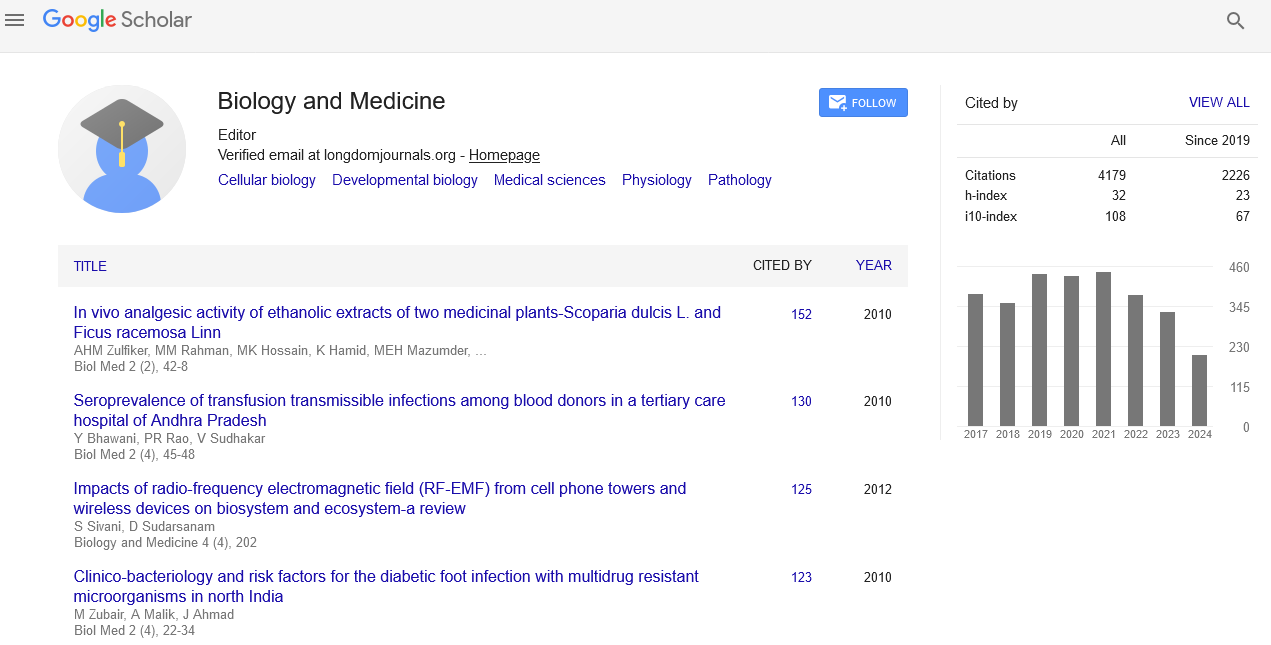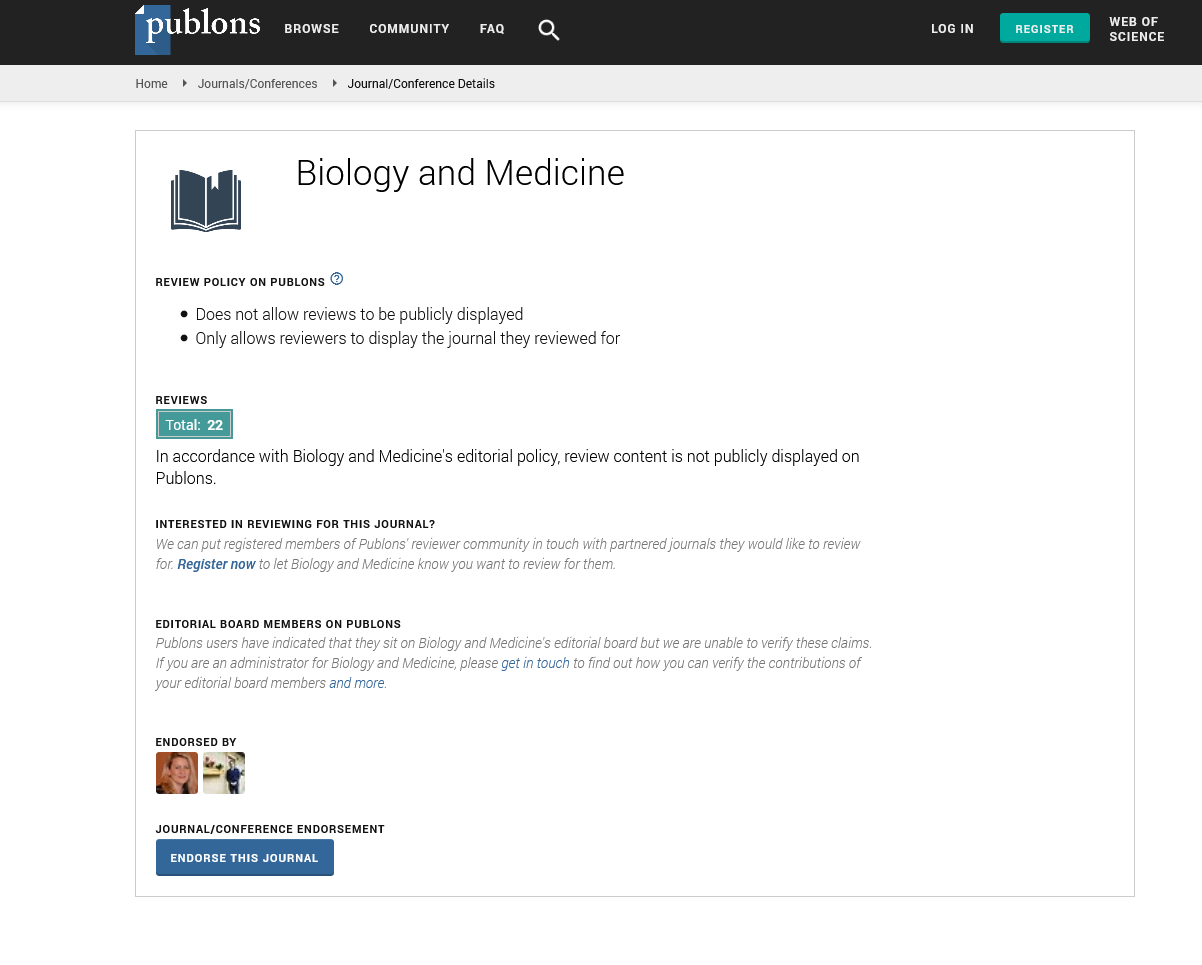Indexed In
- Open J Gate
- Genamics JournalSeek
- CiteFactor
- Cosmos IF
- Scimago
- Ulrich's Periodicals Directory
- Electronic Journals Library
- RefSeek
- Hamdard University
- EBSCO A-Z
- Directory of Abstract Indexing for Journals
- OCLC- WorldCat
- Proquest Summons
- Scholarsteer
- ROAD
- Virtual Library of Biology (vifabio)
- Publons
- Geneva Foundation for Medical Education and Research
- Google Scholar
Useful Links
Share This Page
Journal Flyer

Open Access Journals
- Agri and Aquaculture
- Biochemistry
- Bioinformatics & Systems Biology
- Business & Management
- Chemistry
- Clinical Sciences
- Engineering
- Food & Nutrition
- General Science
- Genetics & Molecular Biology
- Immunology & Microbiology
- Medical Sciences
- Neuroscience & Psychology
- Nursing & Health Care
- Pharmaceutical Sciences
Opinion Article - (2024) Volume 16, Issue 7
Cervical Cancer: The Role of HPV Vaccination and Screening in Prevention
Hafsah Ghanem*Received: 24-Jun-2024, Manuscript No. BLM-24-26736; Editor assigned: 26-Jun-2024, Pre QC No. BLM-24-26736 (PQ); Reviewed: 10-Jul-2024, QC No. BLM-24-26736; Revised: 17-Jul-2024, Manuscript No. BLM-24-26736 (R); Published: 24-Jul-2024, DOI: 10.35248/0974-8369.24.16.702
Description
Cervical cancer, once a leading cause of cancer-related deaths among women, has seen significant advancements in prevention and early detection, largely due to the introduction of Human Papillomavirus (HPV) vaccination and comprehensive screening programs. Despite these advancements, cervical cancer remains a serious health concern, particularly in low-resource settings where access to these preventive measures may be limited. Cervical cancer originates in the cells of the cervix, the lower part of the uterus that connects to the vagina. The primary cause of cervical cancer is persistent infection with certain types of HPV, a sexually transmitted virus. While most HPV infections are transient and resolve without causing harm, some high-risk HPV types, particularly HPV-16 and HPV-18, can lead to the development of precancerous lesions and, eventually, cervical cancer.
HPV is highly prevalent, with the majority of sexually active individuals contracting the virus at some point in their lives. However, the immune system clears most HPV infections naturally. In cases where the virus persists, it can cause abnormal changes in cervical cells, which may progress to cancer over time. This progression typically occurs slowly, often over a decade or more, making cervical cancer one of the most preventable cancers through regular screening and vaccination. HPV vaccines have been used to fight against cervical cancer. The vaccines such as Gardasil and Cervarix, are designed to protect against the high-risk HPV types most commonly associated with cervical cancer. Gardasil 9, the latest vaccine covers nine HPV types, including those responsible for the majority of cervical cancer cases.
HPV vaccination is most effective when administered before individuals are exposed to the virus, which is why it is recommended for preteens, typically around ages 11 to 12, but can be given as early as age 9. The vaccine is also recommended for older adolescents and young adults who have not been vaccinated previously. Studies have shown that HPV vaccination can reduce the incidence of infections with the targeted HPV types by up to 90%, significantly lowering the risk of developing cervical cancer. Countries that have implemented widespread HPV vaccination programs have observed remarkable reductions in the prevalence of HPV infections, as well as decreases in the rates of cervical precancers. For example, in Australia, where the HPV vaccination program has been highly successful, cervical cancer rates have dropped significantly, and it is projected that the disease may be virtually eliminated in the coming decades. This demonstrates the vaccine's potential to drastically reduce the global burden of cervical cancer.
Screening is essential because it can detect precancerous changes in the cervix before they develop into cancer, allowing for timely treatment. The two most common screening methods are the Pap smear (Pap test) and HPV testing. The Pap smear involves collecting cells from the cervix and examining them under a microscope to identify any abnormalities. This test has been the cornerstone of cervical cancer prevention for decades, significantly reducing incidence and mortality rates in countries with established screening programs. However, the Pap smear is not error proof, and false negatives can occur. HPV testing, on the other hand, detects the presence of high-risk HPV types in cervical cells. It is more sensitive than the Pap smear and can be used alone or in combination with the Pap test (co-testing). HPV testing is especially useful for women over 30, as persistent HPV infection at this age is more likely to lead to cervical cancer.
Screening guidelines vary by country, but generally women are advised to begin screening at the age of 21, with the frequency depending on the type of test used and the woman's age. For women aged 30 and older, co-testing with Pap smear and HPV testing every five years is often recommended.Citation: Ghanem H (2024). Cervical Cancer: The Role of HPV Vaccination and Screening in Prevention. Bio Med. 16:702.
Copyright: © 2024 Ghanem H. This is an open-access article distributed under the terms of the Creative Commons Attribution License, which permits unrestricted use, distribution, and reproduction in any medium, provided the original author and source are credited.


